Setembro foi um mês bastante movimentado no Brasil e no mundo para quem deseja comprar um novo telefone. Por aqui, a Motorola lançou novas versões para os seus populares Moto X e Moto G, acompanhada da LG com variantes do G3. Lá fora, a Apple roubou a cena ao apresentar os novos iPhone 6 e iPhone 6 Plus, assim como a Samsung, Sony e Microsoft com mais modelos. Confira os destaques do mês.
Veja também: Conheça os smartphones top de linha do mercado brasileiro
Lançamentos no Brasil
Motorola Moto X (2014)
O Moto X, top de linha da Motorola, ganhou uma nova e mais poderosa versão neste mês. O modelo 2014 do aparelho conta agora com uma tela de 5,2 polegadas Full HD (1080p), Android 4.4.4 (KitKat) e uma câmera de 13 megapixels com flash Dual LED e gravação em 4K, enquanto na parte frontal o sensor possui 2 megapixels. O aparelho traz ainda algumas funções exclusiva da Motorola, como o recurso de controle por voz, o display inteligente e outros.

Novo Moto X da Motorola recebeu melhorias na tela, câmera e especificações (Isadora Díaz/TechTudo)
Na parte interna, o Moto X traz um processador quad-core Snapdragon 801 de 2,5 GHz, 2 GB de RAM e 32 GB de memória interna, sem entrada para cartão de memória. Estão presentes ainda a bateria de 2.300 mAh e as conectividades 4G, 3G, Wi-Fi, NFC e Bluetooth. O Moto X (2014) pode ser encontrado pelo preço sugerido de R$ 1499.
- Motorola Moto G (2014)

O Novo Moto G conta com opção com TV integrada (Foto: Isadora Díaz/TechTudo)
O Moto G também ganhou uma atualização da Motorola. A nova versão do modelo possui 5 polegadas com resolução HD, Android 4.4.4 (KitKat) e câmera traseira de 8 megapixels com gravação HD, além de frontal de 2 MP. O processador é um Snapdragon 400 quad-core de 1,4 GHz, a memória RAM tem 1 GB e o armazenamento interno possui 8 ou 16 GB, expansíveis em até 32 GB por microSD. O aparelho pode ser encontrado na versão com um só chip por R$ 699 ou na versão dual-chip com TV Digital por R$ 799.
- LG G3 Stylus
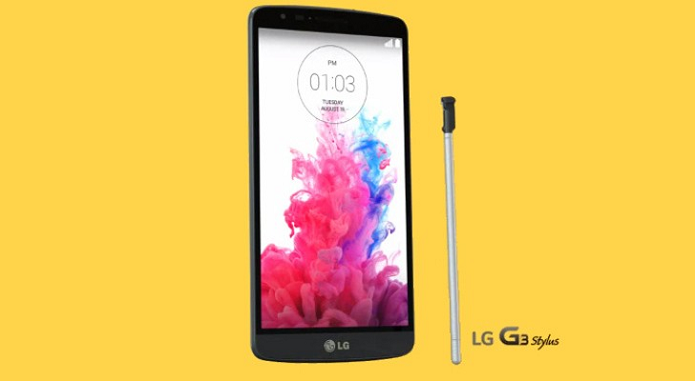
LG G3 Stylus tem tela de 5,5 polegadas, Android KitKat e canetinha (Foto: Divulgação/LG)
O G3 Stylus é uma versão mais simples do top de linha da LG, equipado com Android 4.4.2 (KitKat) e uma caneta Stylus. O aparelho traz ainda uma tela de 5,5 polegadas com resolução de 960 x 540 pixels, câmera traseira de 13 megapixels e frontal de 1,3 MP. Nas configurações há um processador quad-core MediaTek de 1,3 GHz, 1 GB de RAM e 8 GB de memória interna, expansível em até 32 GB. A bateria possui 3.000 mAh e as conectividades 3G, Wi-Fi e Bluetooth completam as configurações. O preço sugerido é de R$ 1.199.
- LG G3 Beat

LG G3 Beat é uma versão mais simples do LG G3 com tela de 5 polegadas (Foto: Divulgação/LG)
O LG G3 Beat é outra versão mais simples do LG G3, equipado com uma tela de 5 polegadas HD (720p), Android 4.4.2 (KitKat) e câmera traseira de 8 megapixels, além de frontal de 1,3 MP. O processador é um quad-core Snapdragon 400 de 1,2 GHz, 1 GB de RAM e 8 GB de armazenamento interno, expansíveis em até 64 GB. A bateria possui 2.540 mAh e as conectividades são 3G, Wi-Fi e Bluetooth. O preço de lançamento sugerido é de R$ 999.
- LG G2 Lite
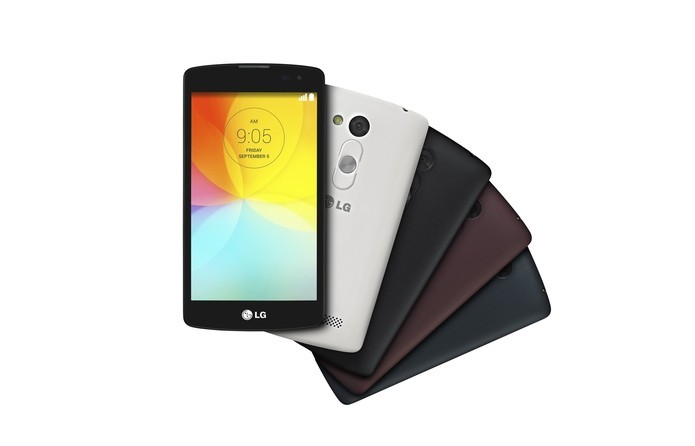
LG G2 Lite tem tela 4,5 polegadas, Android KitKat e processador quad-core (Foto: Divulgação/LG)
O G2 Lite é um aparelho de entrada da LG, equipado com uma tela de 4,5 polegadas com resolução de 800 x 480 pixels, Android 4.4.2 (KitKAt) e câmera traseira de 8 megapixels, além de frontal. Nas configurações, há um processador quad-core 1,2 Ghz, 1 GB de RAM e 4 GB de armazenamento interno, expansíveis em até 32 GB. A bateria do modelo possui 1.820 mAh e as conectividades são 3G, Wi-Fi e Bluetooth.
Destaques internacionais
- iPhone 6
O iPhone 6 é o novo top de linha da Apple que chegou com a aguardada tela Retina de 4,7 polegadas e o iOS 8. Equipado com um display com resolução de 1334 x 750 pixels e densidade de 326 ppi, o aparelho traz ainda uma câmera traseira com 8 megapixels com flash dual-LED e gravação em câmera lenta HD a 240 frames por segundo. Outras novidades são o leitor TouchID e o sistema de pagamento Apple Pay.

iPhone 6 ganhou tela Retina de 4,7 polegadas HD, iOS 8 e processador Apple A8 (Foto: Elson de Souza/ TechTudo)
Nas configurações, o iPhone 6 traz um processador 64 bits dual-core Apple A8 de 1,4 Ghz, 1 GB de RAM e opções de 16, 64 e 128 GB de armazenamento interno, sem espaço para cartão de memória. Completam as especificações a bateria de 1.810 mAh as conectividades 4G, 3G, Wi-Fi, Bluetooth e NFC. Ainda não há previsão de chegada do iPhone 6 e nem preços confirmados para o Brasil.
- iPhone 6 Plus
O iPhone 6 Plus é o primeiro foblet da Apple, equipado com uma tela Retina de 5,5 polegadas Full HD com densidade de 401 ppi. Lançado com o novo iOS 8, o telefone traz ainda câmera traseira com 8 megapixels com flash dual-LED, gravação em câmera lenta HD a 240 frames por segundo e estabilizador óptico de imagens (OIS), gerando vídeos menos tremidos.

iPhone 6 Plus tem tela gigante de 5,5 polegadas e configurações poderosas (Foto: Elson de Souza/TechTudo)
O foblet traz ainda um chip 64 bits dual-core Apple A8 de 1,4 Ghz, 1 GB de RAM e opções de 16, 64 e 128 GB de armazenamento interno, sem espaço para cartão microSD. Há ainda o leitor de digitais TouchID, a função Apple Pay, a bateria de 2.915 mAh e as conectividades 4G, 3G, Wi-Fi, Bluetooth e NFC. O iPhone 6 Plus ainda não tem data de lançamento e nem preços divulgados no Brasil.
- Samsung Galaxy Note 4
Galaxy Note 4 é a nova versão do foblet da Samsung, equipado com a caneta S Pen e o Android 4.4 (KitKat). Entre os destaques do aparelho estão a nova tela de 5,7 polegadas com resolução 2K (1440p) e a câmera traseira com 16 megapixels, estabilização óptica (OIS) e gravação em 4K (2180p). Na parte frontal, há ainda um sensor de 3,7 MP com a função Wide Selfie, que tira autorretratos em até 120 graus.
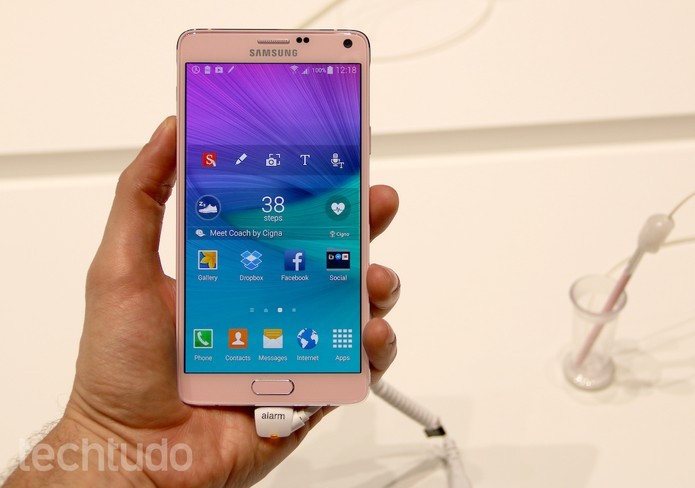
Galaxy Note 4 tem uma tela com resolução QHD, Android KitKat e caneta S Pen (Foto: Fabricio Vitorino/TechTudo)
Nas configurações, o smartphone da Samsung inclui ainda um processador quad-core Snapdragon 805 de 2,7 GHz, 3 GB de RAM e 32 GB de armazenamento, expansíveis em até 64 GB. Há ainda o leitor de impressões digitais, de batimentos cardíacos, bateria de 3.220 mAh e as conectividades 4G, 3G, Wi-Fi, Bluetooth, NFC e Infravermelho. Não há informações sobre a chegada do Note 4 ao mercado brasileiro e nem seu preço no país.
- Galaxy Note Edge
O Galaxy Note Edge é um novo foblet top da Samsung, que tem como diferencial uma pequena tela auxiliar na lateral do aparelho. Com ela, o usuário pode checar diversas informações, consultar atualizações e outros sem sair do app principal. Assim como o Note 4, o aparelho tem uma tela de 5,7 polegadas com resolução 2K (1440p), câmera traseira com 16 megapixels, estabilização óptica (OIS) e gravação em 4K (2180p), além do sensor frontal de 3,7 megapixels com o Wide Selfie.
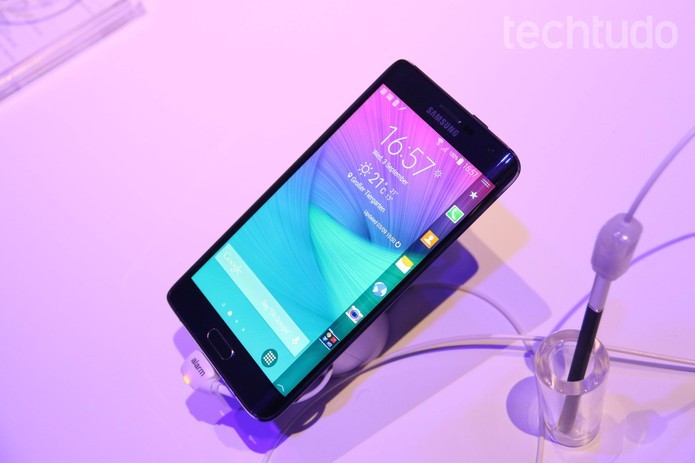
Galaxy Note Edge tem tela auxiliar que pode ser usada para acessar informações adicionais ou abrir apps (Foto: Fabrício Vitorino/TechTudo)
As demais configurações também são idênticas: processador quad-core Snapdragon 805 de 2,7 GHz, 3 GB de RAM e 32 GB de armazenamento, expansíveis em até 64 GB. Outras funções presentes são o leitor de impressões digitais, de batimentos cardíacos, a bateria de 3.000 mAh e as conectividades 4G, 3G, Wi-Fi, Bluetooth, NFC e Infravermelho. O Galaxy Note Edge ainda não tem previsão para chegar ao Brasil.
- Sony Xperia Z3
O Xperia Z3 é o novo top de linha da Sony, equipado com uma tela de Full HD de 5,2 polegadas e o Android 4.4.4 (KitKat). O aparelho tem como grande destaque a sua câmera de 20,7 megapixels com função HDR, gravação em 4K e vídeos em câmera lenta a 120 fps, além de alguns truques divertidos. Além disso, o Z3 traz também uma sensor frontal de 2,2 megapixel, capaz de gravar em Full HD.
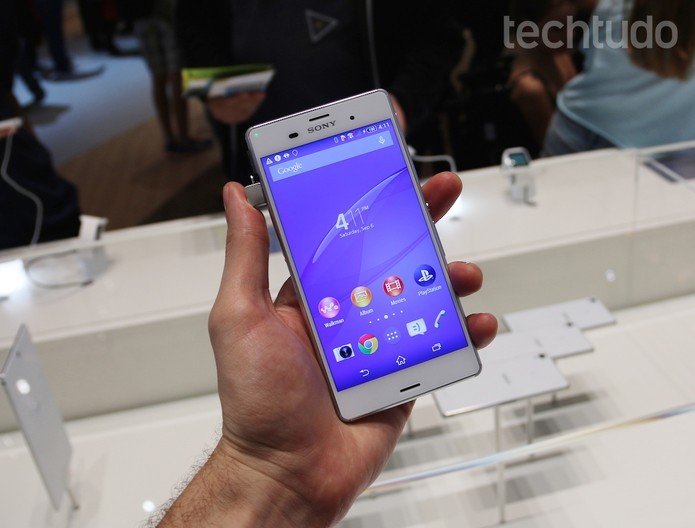
Xperia Z3 tem câmera de 20,7 megapixels, Android KitKat e tela Full HD (Foto: Fabrício Vitorino/TechTudo)
Nas especificações, o top de linha tem um processador quad-core Snapdragon 801 de 2,5 GHz, 3 GB de RAM e 16 ou 32 GB de armazenamento interno, expansíveis em até 128 GB. O Xperia Z3 é a prova d’água e poeira, tem bateria de 3.100 mAh e traz ainda as conectividades 4G, 3G, Wi-Fi, NFC e Bluetooth. Ainda não há preço ou informações sobre lançamento no Brasil.
- Xperia Z3 Compact
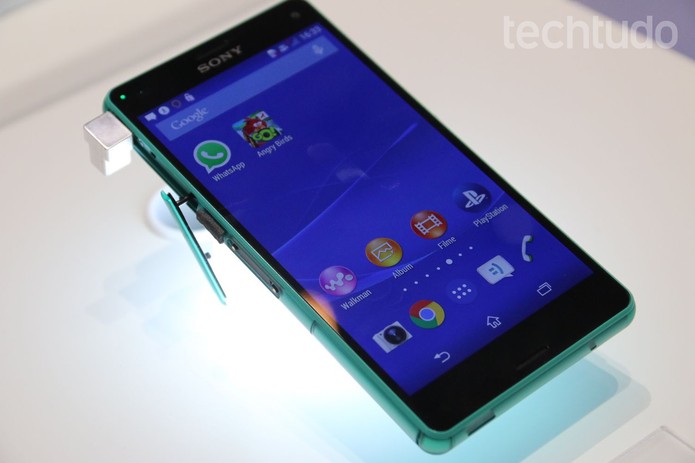
Z3 Compact tem tela menor, câmera de 20,7 megapixels e configurações poderosas (Foto: Fabricio Vitorino/TechTudo)
O Xperia Z3 Compact é uma versão menor do top da Sony, equipada com uma tela de 4,6 polegadas HD (720p) e Android 4.4 (KitKat). O aparelho vem equipado com uma câmera de 20,7 megapixels com gravação 4K (2160p), processador quad-core Snapdragon 801 de 2,5 GHz, 2 GB de RAM e 16 GB de espaço interno, expansível em até 128 GB. Há ainda a bateria de 2.600 mAh e as conectividades 4G, 3G, Wi-Fi, NFC e Bluetooth. A Sony não divulgou nenhuma informação sobre lançamento no Brasil.
- Nokia Lumia 830
O Lumia 830 é, segundo a Microsoft, um novo top de linha “mais acessível” dos que os demais. O aparelho traz uma tela de 5 polegadas HD (720p) e o Windows Phone 8.1 já com a nova atualização Denim, exclusiva da Nokia. Além disso, ele tem uma câmera traseira de 10 megapixels com tecnologia PureView, lentes Zeiss e estabilização óptica de imagem (OIS), além de uma câmera frontal de 0,9 MP.
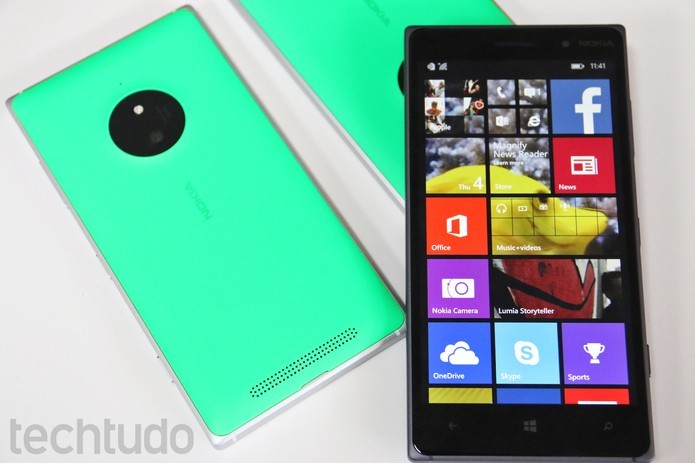
Lumia 830 tem Windows Phone 8.1 Denim, câmera de 10 megapixels e processador quad-core (Foto: Fabrício Vitorino/TechTudo)
Nas configurações internas, o aparelho da Microsoft possui um processador quad-core Snapdragon 400 de 1,2 GHz, 1 GB de RAM e armazenamento interno de 16 GB, expansíveis em ate 128 GB. Há ainda a bateria de 2.200 mAh e as conectividades 4G, 3G, Wi-Fi, NFC e Bluetooth. O aparelho ainda não foi oficialmente lançado no Brasil.
- Nokia Lumia 735
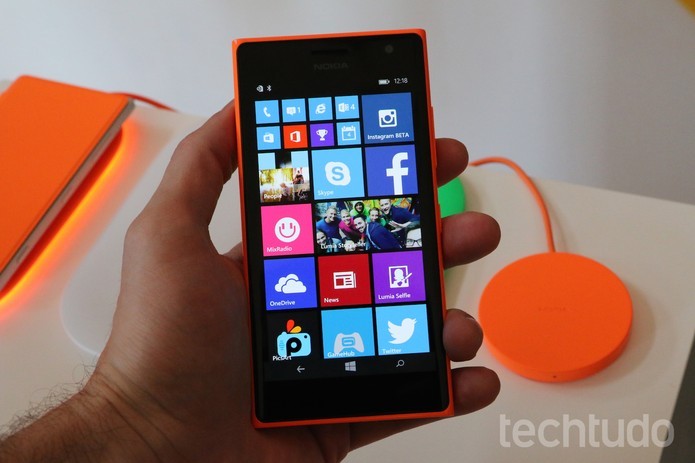
Lumia 735 tem conectividade 4G e câmera frontal de 5 megapixels para selfies (Foto: Fabrício Vitorino/TechTudo)
O Lumia 735 é um novo intermediário da Microsoft com foco nos Selfies e na Internet de alta velocidade com o 4G. Ele traz uma tela de 4,7 polegadas HD, Windows Phone 8.1 Denim, câmera traseira 6,7 megapixels com gravação em Full HD e um sensor frontal de 5 megapixels especialmente desenvolvido para autorretratos. Há ainda um processador quad-core Snapdragon 400 de 1,2 Ghz, 1 GB de RAM e 8 GB de armazenamento interno, expansíveis em até 128 GB. Completam as especificações a bateria de 2.200 mAh e as conectividades 4G, 3G, Wi-Fi, Bluetooth e NFC. Ainda não há previsão de chegada ao Brasil.
- Nokia Lumia 730 Dual SIM
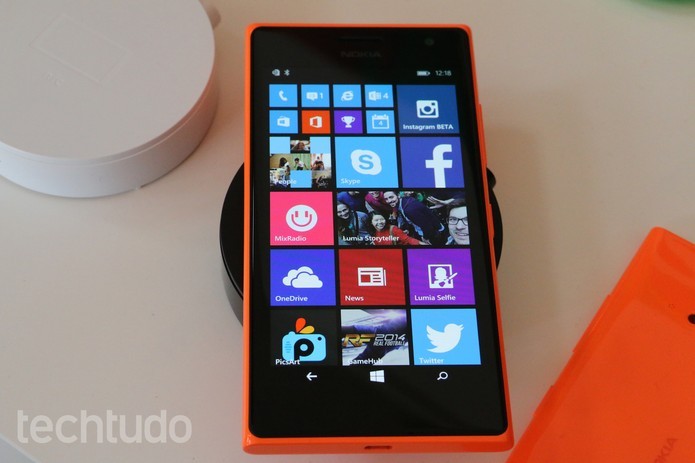
Lumia 730 tem função dual-chip, processador quad-core e câmera frontal para selfies (Foto: Divulgação/Microsoft)
O que mais falta nos celulares modernos? Comente no Fórum do TechTudo
O Lumia 730 é praticamente idêntico ao 735, exceto pelo suporte a dois chips de operadoras. Equipado com uma tela de 4,7 polegadas HD, o aparelho possui Windows Phone 8.1 Denim, câmera traseira 6,7 megapixels Full HD e um sensor frontal de 5 megapixels com resultados superiores em selfies. O processador é quad-core Snapdragon 400 de 1,2 Ghz, 1 GB de RAM e o armazenamento interno tem 8 GB, expansíveis em até 128 GB. Já a bateria possui 2.200 mAh e as conectividades são 3G, Wi-Fi, Bluetooth e NFC. Não há detalhes sobre lançamento no Brasil.


































